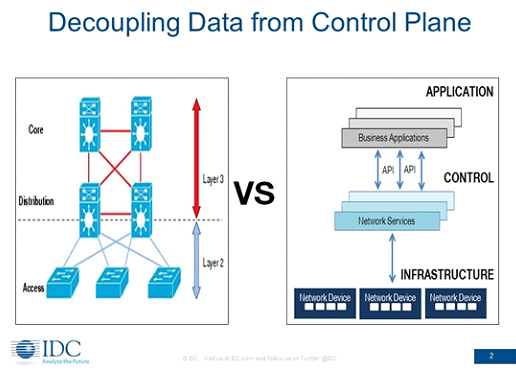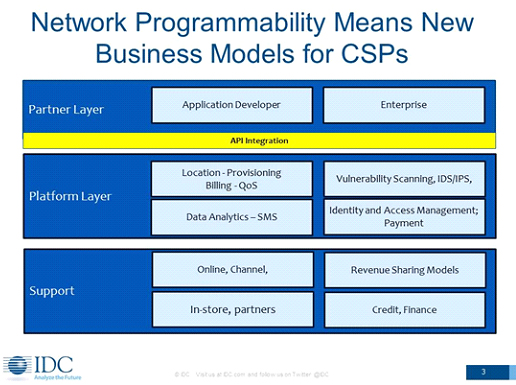By Lionel Snell, Freelance Editor
Software Defined Networking (SDN) was a major theme at NetEvents APAC press Summit in February 2013, beginning with a keynote speech by Rick Bauer, Technical Programs Manager, of the Open Networking Foundation (ONF). The same morning Dustin Kehoe, Assoc. Research Director for IDC Australia, chaired a discussion entitled SDN – fertile ground for a network app store?
He began by explaining how SDN decouples the data and control planes – Fig 1. In the old 3-layer architecture, he said: “The core is anything that touches your backbone, where the SPs have their big investments. Aggregation is your subnets and your VLANs and things that connect there. And access is connecting the end user to data, to the Internet… this whole topology is largely north/south – it doesn’t really address east/west.” He did not see a direct move from that model to SDN, instead there was an intermediate stage of simpler, flatter architectures, leading to protocol consolidation.
SDN, however, allows the network to become programmable – bringing the benefits of flexibility, control and automation: “The average cloud environment might have 50 dedicated servers to one admin, and what you really need to get to is 500 servers to one admin, or what happened in the case of Microsoft, 10,000 servers. Without automation we don’t have speed and scale – the very reason we want to go to cloud”.
Programmability also introduces a two-sided business model to counter the losses made by carriers to OTT providers: “With the intelligence that sits in the network you have location provisioning, the ability to provision really quickly, you have the billing component, but also can enable quality of service across the network. You can use payment to social networks and access gateway security… if you can figure out programmability and applications you can probably figure out good revenue sharing models. Let’s also face it, you’re really good at credit risk and analysis and revenue insurance, which your average start-up doesn’t really know a lot about.” Fig 2
Moving on to today’s most prevalent SDN solution, OpenFlow standard, we find a vendor agnostic protocol that could be the basis for a whole new market of networking “app stores”, where a new generation of network programmers can showcase their offerings. This not only opens up a new industry it also suggests business opportunities for service providers to move from a network connectivity based operating model to a new role as “applications broker”.
SDN as a disruptive technology
Most of current discussion about SDN focuses on how it works and the benefits it offers. What is not so often discussed is its potential impact on the entire networking industry.
When the mainframe gave way to the personal computer, an industry built around closed, proprietary hardware running its own operating system and custom made applications, gave way to a population of personal computers based on commercial chips. These gave users a choice of Mac, Windows or Linux operating platforms to support off-the-shelf applications of every description – and the whole industry was transformed during the course of a decade.
The same thing could happen in the networking industry. Tightly integrated around closed proprietary systems, the industry is experiencing a similar de-coupling of its layers as SDN separates out the control plane from the data plane and – following the example of the OpenFlow protocol – allows an open interface to a new breed of switches from diverse vendors built on powerful merchant silicon, and an open interface to a future population of off-the-shelf network applications.
Where the network becomes programmable at every layer, there will be opportunities for specialist vendors. At the physical layer there will be vendors building SDN-enabled switches, and competitive pressures will force them to allow open APIs on which another group of independent vendors can build a range of network operating systems addressing specific needs such as fault tolerance, memory protection or dynamic loading.
More surprisingly, there could also be a choice of platforms for network applications – like choosing between Windows or Mac. Consider the range of services running on one typical enterprise network. The security department, the IT department and manufacturing may all be using the same infrastructure, but they will want an interface that addresses their own business needs, without being distracted by functions used by other departments. Specific platforms will be developed to address specific business functions.
Finally we have an open market for network applications addressing both general needs such as traffic optimization and niche services such as monitoring cost savings from smart lighting across an office site. There are just so many opportunities here that we will see the growth of not just one app store but specialist stores for niche markets – a security app store, a cloud datacenter app store, a video management app store and so on. Windows and Mac now run on the same Intel chips but offer a different user experience. That’s the choice the user wants – more than the underlying nuts and bolts – and there is enormous scope for creative design and clever niche offerings based on the same SDN framework.
Is it actually happening?
SDN has the potential to revolutionise the networking industry, and to open up significant new business opportunities for service providers and carriers. But is it likely to happen? It depends on the industry taking up SDN in a big way.
According to Dustin Kehoe: “We [IDC] forecast the SDN market could represent 35 percent of datacentre switching by 2016. In real terms, excluding Japan, that’s $750m that the incumbent switching vendors stand to lose. We see the market wide open to software vendors like Oracle, virtualisation providers like VMware, and over the top providers and carriers. It’s a wide open playing field from our perspective.”
In his opening keynote at NetEvents Thailand, Rick Bauer, Technical Programs Manager, of ONF, gave examples of SDN already in action. Significant numbers of vendors have already provided OpenFlow protocol in their switches and a growing number of open-source SDN controllers are available. Leading carriers are already implementing SDN and OpenFlow protocol – AT&T and IBM announced in October 2012 their secure SDN cloud services enabling fast and highly secure shared cloud storage and cloud services.
Google has been using OpenFlow protocol since 2010 to control traffic in a WAN connecting datacenters across North America, Europe and the APAC region and, according to Jim Wanderer, Google’s Director of Engineering, Platforms Networking: “Google couldn’t have achieved the results it has without SDN. We could have used other approaches, but there’s no way that the results would have been as effective. As a result of this success, Google is now committed to further SDN deployments.”
SDN is being taken up by these leading players, but what about the business majority – where is the action taking place? At the discussion following Dustin Kehoe’s presentation, Ed Chapman, VP Business Development and Alliances, Arista Networks, emphasized the adoption of SDN by tier one service providers and over-the-top operators: “They’re doing it to reduce cost, to reduce complexity, being able to provision services very fast. I don’t see a lot of enterprise deployments, yet. I think they just don’t have the same requirements that the service providers have, or the over-the-top providers, for this sort of architecture.”
Another panelist, Kash Shaikh, Senior Director, Product & Technical Marketing, HP, had a different opinion: “We are seeing more interest than we expected from the enterprises regarding our cloud network application. Even within enterprises, a lot of discussion has been around data centres. We are seeing a lot of interest from the enterprises in the campus deployments. It’s really about the applications if you tell the enterprises what they can do – they’re looking for a solution to solve their business challenges. There is a lot of interest, and it’s across the board.”
Summing up, Rick Bauer was asked if he saw a bright future for SDN and he replied: “Very much so! I think the innovation that’s going on, the extent of the collaboration across networking companies, software companies, telcos and cloud providers is unprecedented in these time scales – it’s hard to believe that in only 18 months we have gone from promise and research to the exciting announcements being made today.”
So the ground is being prepared, and it does look as if it will eventually become fertile ground for not just one but a whole population of network app stores.





















































































































